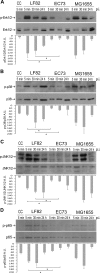The Adherent/Invasive Escherichia coli Strain LF82 Invades and Persists in Human Prostate Cell Line RWPE-1, Activating a Strong Inflammatory Response
- PMID: 27600504
- PMCID: PMC5067744
- DOI: 10.1128/IAI.00438-16
The Adherent/Invasive Escherichia coli Strain LF82 Invades and Persists in Human Prostate Cell Line RWPE-1, Activating a Strong Inflammatory Response
Abstract
Adherent/invasive Escherichia coli (AIEC) strains have recently been receiving increased attention because they are more prevalent and persistent in the intestine of Crohn's disease (CD) patients than in healthy subjects. Since AIEC strains show a high percentage of similarity to extraintestinal pathogenic E. coli (ExPEC), neonatal meningitis-associated E. coli (NMEC), and uropathogenic E. coli (UPEC) strains, here we compared AIEC strain LF82 with a UPEC isolate (strain EC73) to assess whether LF82 would be able to infect prostate cells as an extraintestinal target. The virulence phenotypes of both strains were determined by using the RWPE-1 prostate cell line. The results obtained indicated that LF82 and EC73 are able to adhere to, invade, and survive within prostate epithelial cells. Invasion was confirmed by immunofluorescence and electron microscopy. Moreover, cytochalasin D and colchicine strongly inhibited bacterial uptake of both strains, indicating the involvement of actin microfilaments and microtubules in host cell invasion. Moreover, both strains belong to phylogenetic group B2 and are strong biofilm producers. In silico analysis reveals that LF82 shares with UPEC strains several virulence factors: namely, type 1 pili, the group II capsule, the vacuolating autotransporter toxin, four iron uptake systems, and the pathogenic island (PAI). Furthermore, compared to EC73, LF82 induces in RWPE-1 cells a marked increase of phosphorylation of mitogen-activated protein kinases (MAPKs) and of NF-κB already by 5 min postinfection, thus inducing a strong inflammatory response. Our in vitro data support the hypothesis that AIEC strains might play a role in prostatitis, and, by exploiting host-cell signaling pathways controlling the innate immune response, likely facilitate bacterial multiplication and dissemination within the male genitourinary tract.
Copyright © 2016 Conte et al.
Figures





References
MeSH terms
Substances
LinkOut - more resources
Full Text Sources
Other Literature Sources

